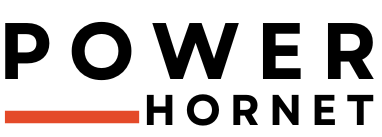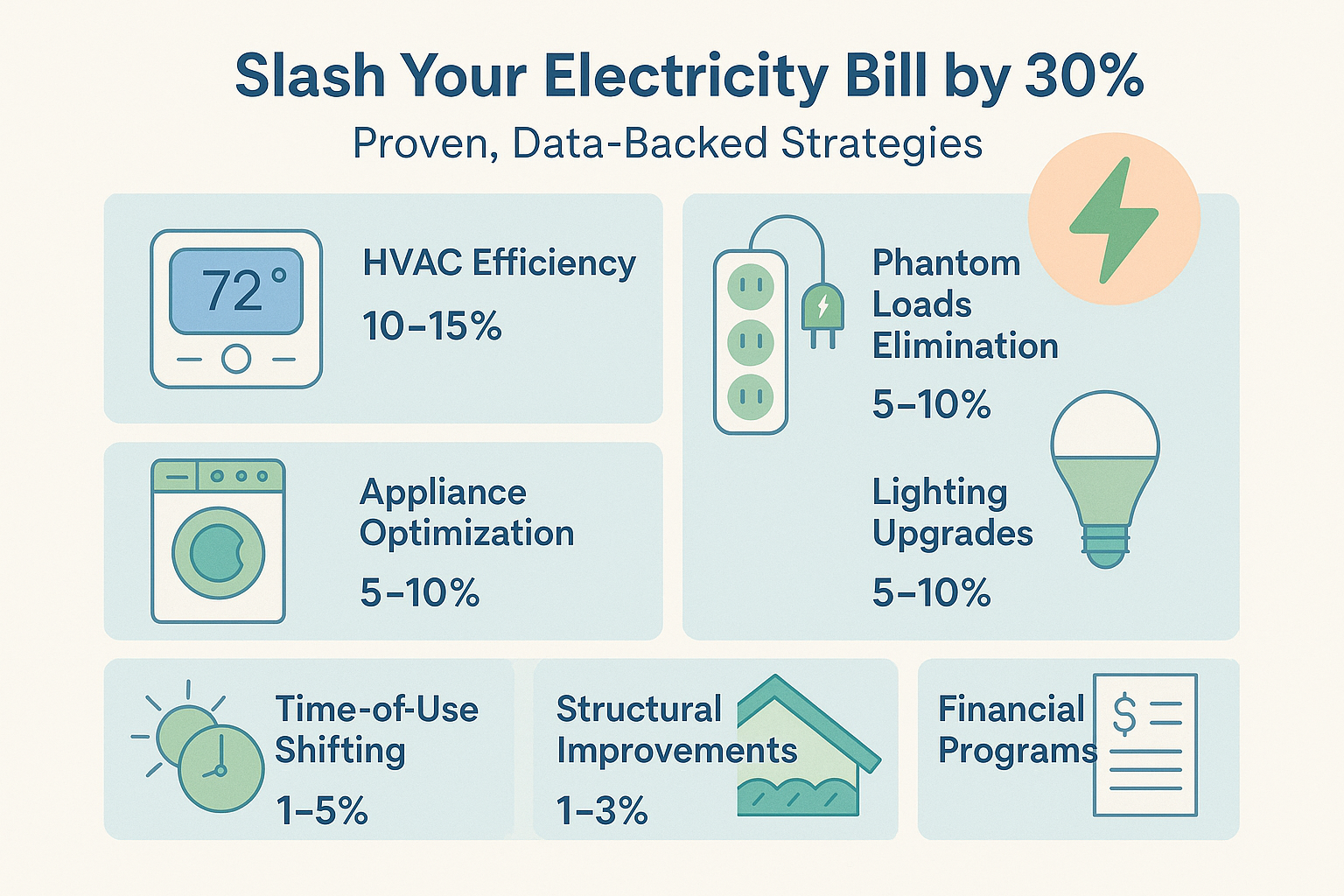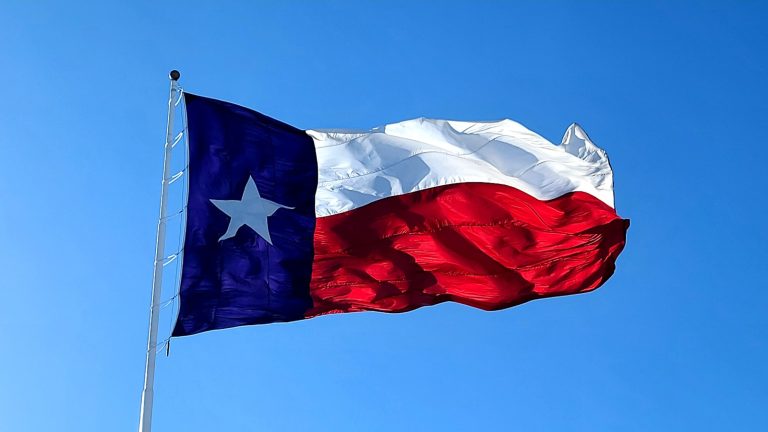Slash Your Electricity Bill by 30%: Data-Backed Strategies
As electricity prices rise and household budgets tighten, cutting energy costs is no longer optional—it’s essential. Today, electricity consumes 6–8% of average U.S. household income, with the typical family spending $137 monthly (or $1,640 per year). That number is projected to grow another 13% by 2025, especially in states with extreme weather or time-of-use pricing.
But here’s the good news: homeowners across the country are slashing their bills by 30% or more by combining smart habits, targeted upgrades, and leveraging available programs. This guide outlines proven, cost-effective strategies—from quick wins to long-term investments—that can start saving you money immediately and sustain those savings for decades.
1. Master HVAC Efficiency (40–54% of Your Bill)
Heating and cooling systems account for the largest share of residential energy use. Optimizing them is the single most effective way to cut costs.
What Works:
- Thermostat Optimization: Setting your thermostat 7–10°F lower in winter (or higher in summer) for 8+ hours daily (e.g., during sleep or while away) can cut heating and cooling bills by up to 10% annually.
- Example: A programmable or smart thermostat learns your routine and adjusts automatically—even when you’re not home.
- Routine Maintenance: Dirty filters reduce airflow and strain systems, increasing consumption by up to 30%.
- Replace filters every 1–3 months and schedule annual tune-ups to keep your system running efficiently.
- Seal and Insulate Ducts: About 20–30% of conditioned air is lost through leaky ductwork. Use mastic sealant or metal tape (not duct tape) and insulate ducts in attics or crawl spaces to prevent energy loss.
- Window Strategies: Block heat in summer with blackout curtains or blinds on south- and west-facing windows. In winter, open those blinds during sunny hours for passive heating.
Pro Tip:
Smart thermostats often come with utility rebates, further reducing their cost. Some states even offer free installation under energy-saving programs.
| HVAC Strategy | Estimated Annual Savings | Implementation Cost |
|---|---|---|
| Smart Thermostat | 10% ($160/year) | $100–$250 (before rebates) |
| Sealing Ducts | 15–20% on cooling/heating | $50 DIY – $500 pro |
| Annual Tune-Up | Prevents 15–30% waste | $70–$150 |
| Blackout Curtains | 5–7% on cooling | $20–$50 per window |
2. Eliminate Phantom Loads (5–10% of Your Bill)
Idle electronics, or “energy vampires,” draw power even when off. They can cost you $100–$165 a year, silently draining your wallet.
What Works:
- Smart Power Strips: These detect when a main device (like your TV) is off and cut power to accessories (e.g., soundbars, gaming consoles).
- Unplug the Worst Offenders:
- Old tool chargers: $10–$14/year when left plugged in
- Laptop chargers: ~$6/year
- Modern phone chargers use < $0.30/year—but why waste it?
- Eco Mode Settings: Many TVs, monitors, consoles, and even printers have “sleep,” “eco,” or “low-power” settings. Turn them on.
Pro Tip:
Label outlets with stickers (“Unplug me!”) to build awareness among family members, especially around desks and entertainment centers.
3. Optimize Major Appliances (20–30% of Your Bill)
Your appliances—especially for water heating, cooking, and laundry—offer substantial savings with just a few adjustments.
Water Heating (~18% of bill)
- Set temperature to 120°F (safe and efficient)
- Install low-flow showerheads to reduce hot water use
- Consider switching to a tankless water heater (35–45% more efficient, ideal for households with moderate hot water use)
Kitchen Efficiency
- Set refrigerator to 37–40°F, freezer to 0–5°F
- Clean refrigerator coils quarterly to maintain performance
- Use ECO mode on dishwashers, and air-dry instead of using the heating element
Laundry Savings
- Wash with cold water: Heating accounts for 90% of a washer’s energy use
- Always clean the lint filter before drying to maintain airflow
- Line-dry when possible—sunlight is free!
4. Lighting & Plug Load Efficiency (Up to 15% Savings)
Lighting and devices plugged into walls still make up a major chunk of usage—especially in older homes.
What Works:
- LED Bulbs: Replace incandescents with LEDs, which use 75–90% less energy and last 15–25 times longer
- Smart Sensors & Dimmers: Use motion detectors in garages or hallways and dimmers in bedrooms/living rooms to customize brightness and reduce usage
- Natural Light Optimization: Open blinds during the day, repaint dark walls with lighter tones, and strategically position mirrors to spread sunlight
5. Master Time-of-Use (TOU) Billing: Save 20–50% on Peak Costs
In TOU plans, utilities charge more during demand surges—usually 4–9 pm. Avoiding these times can save hundreds.
What Works:
- Shift Use to Off-Peak: Run appliances like dishwashers and EV chargers before 4 pm or after 9 pm
- Solar + Battery Storage: Install a battery backup to store cheap midday solar energy and discharge during peak
- Example: A California homeowner saved $1,440/year with a 2.4 kW solar array + 10 kWh battery
- Pre-Cooling or Pre-Heating: Run your HVAC early in the day to “store” cool or warm air during cheap hours
| Task | Off-Peak Rate | Peak Rate |
|---|---|---|
| EV Charging (CA) | 23¢/kWh | 58–61¢/kWh |
| Dishwasher (night) | $0.18/load | $0.40+/load |
| Battery Discharge Savings | 30% bill offset | — |
6. Invest in Structural Upgrades (Long-Term 20–35% Savings)
If you’re planning to stay in your home, these upgrades pay dividends every month.
What Works:
- Insulate Your Attic: Upgrading to R-38 insulation can cut HVAC needs by 25%+, especially in older homes
- Energy-Efficient Windows: ENERGY STAR-certified windows reduce heat gain/loss; insulating films offer a cheaper interim solution
- Air Sealing: Use caulk, foam gaskets, and weatherstripping to seal cracks, gaps, and outlets
Payback Periods:
- Attic insulation: 2–4 years
- Window film: <1 year
- Energy Star windows: 6–15 years depending on climate and usage
7. Leverage Financial Programs and Rebates
Millions of households leave money on the table by not applying for energy assistance or rebate programs.
What’s Available:
- CARE/FERA (California): 30–35% utility discount for income-qualified households
- Weatherization Assistance Program (WAP): Offers free insulation, window sealing, and appliance upgrades in all 50 states
- Federal Solar Tax Credit (ITC): Covers 30% of solar installation costs through 2033
- Local Utility Audits: Many utilities offer free or discounted home energy audits, with upgrade rebates worth hundreds
Implementation Roadmap: Your Energy-Saving Timeline
| Phase | Action Steps |
|---|---|
| 0–3 Months | Install smart strips, LED bulbs, lower water heater temp, seal windows/doors |
| 3–12 Months | Add attic insulation, clean HVAC filters, install a smart thermostat |
| 1–5 Years | Upgrade HVAC, install solar + battery, replace old appliances with Energy Star |
“By installing solar with a 10kWh battery system, I cut my $4,800 annual bill by 30%. The system paid for itself in just under 4 years.” — California homeowner
Why 30% Savings Is Realistic
The combined impact of smart behaviors, strategic timing, and targeted upgrades adds up:
| Source of Savings | Estimated Impact |
|---|---|
| HVAC Optimization | 10–15% |
| Phantom Load Elimination | 5–10% |
| Appliance & TOU Efficiency | 7–12% |
| Lighting/Structural Upgrades | 5–8% |
In many high-cost regions, households are even exceeding 40% total savings—without sacrificing comfort.
Final Tip: Track, Adjust, Repeat
Monitor your real-time electricity use via your utility provider’s app or web portal. Compare monthly bills, track peak-hour usage, and adjust strategies accordingly. Consider tracking changes with a simple spreadsheet or app like Sense or Emporia Vue to visualize savings over time.
“What gets measured gets managed.” – Peter Drucker
Take Action Today: Whether you’re renting an apartment or owning a home, there’s a place to start. Begin with low-cost, high-return steps, and build your way to deeper savings that pay back year after year.





